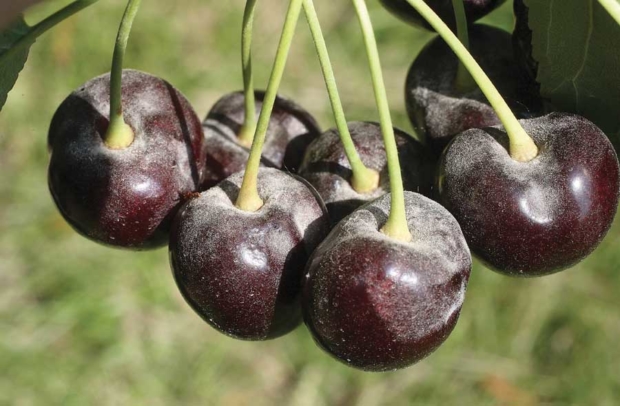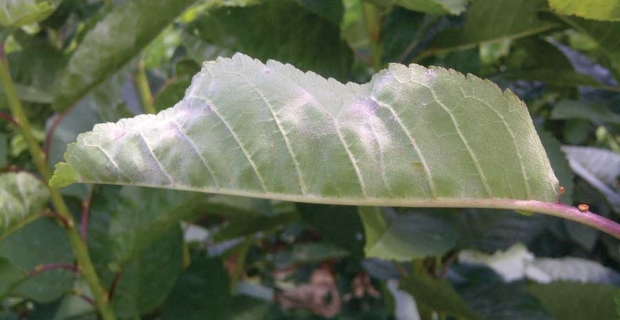
Scientists aren’t sure why powdery mildew infects cherries in the Pacific Northwest but not fruit in other cherry growing regions around the world. (Courtesy Gary Grove, Washington State University
There is still much to be known about why cherries are so susceptible to powdery mildew — in ways that many other fruits are not — but researchers are narrowing the window of when cherries are most susceptible to the disease and determining just how many spores pose a problem at harvest.
Mildew can affect both the leaves and the fruit on the same tree. Fungicides can adapt to deal with mildew on one or the other. A three-year project by Washington State University researchers centered on infection of the fruit itself.
Dr. Claudia Probst, project lead and research associate at Washington State University’s Irrigated Agricultural Research and Extension Center in Prosser, Washington, examined trees and fruit closely, starting at full bloom, to determine if the presence of fungus has any effect on the presence of the disease at harvest and to see if resistance and susceptibility vary at different developmental stages of fruit.
Environmental factors, such as temperature and relative humidity, and inoculum concentration thresholds also were taken into consideration to see how many spores were necessary to have the disease show at harvest.
Probst presented the latest findings on this powdery mildew research at several winter meetings, including November’s Northwest Cherry Research Review and the Washington State Tree Fruit Association’s annual meeting in December.
Seeking spores
The flowering stage has been of particular interest to researchers because, for a lot of commodities, flowers are highly susceptible to infection, Probst said.
For instance, strawberry blooms are highly susceptible to infection, but as soon as the fruit reaches the white or pink stage, generally within about two weeks, it becomes fully resistant.
“This has major implications for disease control,” Probst said. “This is called ontogenic resistance. It’s seen in grape berries at about four to six weeks.”
The good news: Cherries have a long period of resistance, which is fabulous, she said. However, cherries’ resistance to mildew declines over time, which means they have no ontogenic resistance. Additionally, the period from pre-bloom to fruit set in cherries was not a critical period for establishment of powdery mildew infections, the research showed.
“Flowering precedes natural onset of disease on leaves,” she said. “Airborne spores are detectable, but at very low concentrations, and cherries covered at fruit set were not infected at harvest, so the timing between bloom and fruit set is not critical for diseases that present at harvest.”
Generally, Probst said, the more spores the more disease; however, few spores are needed to cause significant damage. There could be as many as 10,000 spores during the season, but cherries only need about 500 spores to see significant infection at harvest.
Other factors
Researchers also examined the effects of temperature and humidity on disease incidence and severity at various stages of fruit development. Probst called these the most “frustrating experiments” she had ever done.
“We processed thousands of these cherries, and we just couldn’t get disease to develop. The only time we got disease to develop was on fruit harvested in mid-June,” she said.
Disease can initiate year-round on susceptible leaves, with an optimal temperature, relative humidity and incubation period, she said, but “temperature and humidity alone are not enough to start infection on cherries.”
In future studies, Probst will study the sudden transition from resistance to susceptibility that appears to occur in the month of June in hopes of determining the trigger.
Overall, fruit infection is a silent and highly unpredictable process, while infections of leaves is “loud and in your face,” she said. “With fruit, you have to just wait and see what you get at harvest.”
Future research
Powdery mildew spores can live for up to two months on sweet cherries — a situation that is unique to cherries.
For that reason, the latest findings present new areas for research, such as examining the role of cherry fruits in the fungal life cycle, points of infection, and the impact of cherry volatiles on spore germination, Probst said. Skeena cherries, for example, produce three times more alcohol than Lapins, which could play a role.
She also aims to discover what she calls the “ABC’s” of powdery mildew with hopes of achieving sustainable disease management techniques.

Powdery mildew was once only known to occur in leaves, but since 1944, the fungus has affected cherries, too — but only in the Pacific Northwest. (Courtesy Claudia Probst)
Prior to 1944, powdery mildew was only known to occur in leaves, but the fungus has affected cherries in the Pacific Northwest ever since. Other key cherry growing regions do not have powdery mildew issues: Chile and Turkey have no mildew.
Spain doesn’t even spray for it, and in Italy, a fellow researcher had to Google fruit symptoms on the Internet to tell her it’s not an issue there, Probst said.
Germany saw it on leaves in 2004 but not since, she said, and it appears on leaves in Iran once in a while but never on fruit.
“What happened in Washington in 1944 to make that fungus decide to jump from the leaves to the fruit?” she asked. “That’s where adaptation becomes of real interest to us.”
Growers have an opportunity to understand more about the disease, and controlling with spray is a short-term view, she said. “The goal is to keep pathogen populations under sustained disruptive pressure and provide an additional layer of protection against the disease.” •
– by Shannon Dininny






Leave A Comment